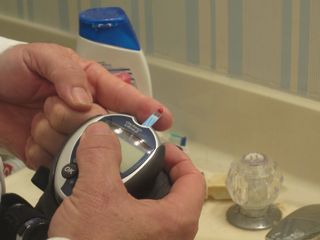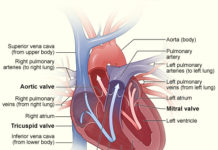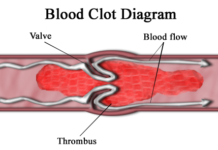My Dad was diagnosed with type 2 diabetes when he was only 39 years old. “At first I was in disbelief and that I didn’t think that this would happen to me,” he recalls.

The 2011 National Diabetes Fact Sheet states that there are 25.8 million children and adults in the United States that have diabetes, 7 million are undiagnosed.
Before his diagnosis, my Dad was constantly eating, and did not exercise much. His parents had developed diabetes when they entered their eighties. Considering that my grandparents and my Dad have all been diagnosed with diabetes means that I run a great risk of becoming diabetic also.
My Dad had experienced several early signs of diabetes that made him believe that he might be diabetic. He never felt dizzy or nauseous, but he persistently became tired, thirsty and had frequent urination.
There are 79 million people, in the United States that are pre-diabetics. Pre-diabetes means that a person has higher blood sugar levels than a regular person should have, but the levels are not high enough for the person to be diagnosed with diabetes.
“You need to take into consideration of what our society has come to,” says my Dad. “What we eat and how much we exercise has changed dramatically from when I was a little kid and when your grandparents were little kids. I believe that it is not unusual for a person to develop diabetes at any given age in this century.”
Type 1 diabetes is mainly associated with young kids and young adults. If a child or young adult has type 1 diabetes their bodies produce too little or no insulin. As a result, young type 1 diabetics have to receive insulin shots one or two times in a day for the rest of their lives. The onset for young type 1 diabetics can come with no warning.
Type 2 is the most common type of diabetes. It develops at a much slower rate than type 1. For type 2 diabetics, sugar can be very harmful. So, they really have to watch their intake of sugar. This form of diabetes is also known as age-onset or adult-onset, which typically affects people over the age of 40. Adult-onset is a mild type of diabetes, and can be brought on earlier by being obese or constantly having stress in your life. However, adult-onset diabetes can be easily managed by following a diet.
“On the bright side I have begun to try new physical activities, like riding bikes and swimming, that I thought I would never do. I feel so refreshed after those activities,” said Dad while smiling.
Diabetic patients have many more options on how to keep their diabetes under control than years ago. For example, diabetics can test their blood sugar levels at home, change their diets, exercise multiple times each week, and have better access to insulin.
“I measure my blood sugar once a day to make sure I am controlling the progress of the glucose in my body. By keeping the blood sugar level around 6.5-7.0, in the normal range, I can lead a healthier life style,” explains my Dad.
Diabetics can also use insulin pens that report your sugar level. My Dad uses an Accu-Chek Softclix Lancet Device that obtains a drop of blood from his fingertip. He places the drop of blood on a test strip tests his blood sugar levels.
Today there is a treatment called the HbA1c (glycosylated hemoglobin type A1c), which measures the average of the red blood cells’ glucose levels. This test is typically done every two to six months. This test gives an accurate indication of the average number of your blood glucose levels over the past one to three months, says Diabetes UK. The test’s main goal to lower HbA1c to a number agreed upon between you and your doctor. My Dad undergoes this treatment once every three months.
My Dad takes three different types of pills, which helps his pancreas by increasing the amount of insulin. This helps break his food down better and gives him more energy.
My Dad’s doctor, Edward Heidbrier with Clayton Medical Associates, prescribed two pills for the diabetes. Metformin helps to manage my Dad’s blood sugar, avoid kidney damage, blindness, and nerve problems. Glipizide Extended-Release stimulates the discharge of the natural insulin that your body creates.
Another modern day treatment is an injection called exenatide. Exenatide stimulates insulin emission in reply to glucose and prevents the release of the hormone glucagon, which increases glucose production in the liver.
If my Dad had not gotten treatment with his pills, then he would have been at risk of having to amputate his toes, feet, or legs when he got older, because, according to Insulite Laboratories, my Dad would have been at risk of developing a nerve disease called diabetic neuropathies. He would also have been at risk of suffering from blindness, kidney failure, and heart disease.
The American Diabetes Association states that diabetics have a greater risk of heart attack or stroke. In addition, the US Department of Health and Human Services explains that diabetic retinopathy is the main reason that adults 20 and over suffer different levels of blindness.
“I had a cataract removed from my right eye and have experienced some tingling in the feet,” says my Dad. “The tingling in my feet is not at a severe level. They have been at the same level since I was diagnosed with diabetes, so I am not worried. If you are a newly diagnosed diabetic, I would make sure your doctor knows [about the tingling]. So, if the tingling does worsen in your feet, then your doctor can take the steps to help you.”
My Dad’s lifestyle has changed. He has switched from drinking regular soda to diet, stopped eating cookies and cake, and gave up fried foods for more baked foods. He also started to exercise more. ”That at first it was difficult to not eat sweets with my friends, but as time went on I got used to the fact that I could not eat sweets.”
“I try to prepare meals from a healthy perspective; limiting the fat, sugar and sodium, and incorporating vegetables, fruits and whole grains, while limiting the red meat, says my Mom, a registered dietitian. “Controlling portion size is very important especially if you are a diabetic.”
| Related stories: Cause and Effects of Diabetes, Immigration and Living with Type 2 Diabetes |
She says that adults with diabetes can control their blood sugar levels by following diet plans prescribed by a registered dietitian, maintaining an ideal body weight, and getting plenty of exercise. My Mom says that families of a diabetic should get in contact with a registered dietitian for a personal diet plan, nutritional counseling, and other helpful information on daily exercise. Her advice for newly diagnosed diabetics is to get support from their family and friends, and to take their medicine as directed. “Newly diagnosed diabetics need to know the consequences of taking their diet lightly by indulging in sweets because it could result in long term health consequences for them,” she adds.
My Dad eventually accepted his disease and learned how to live with it in his daily life because of the support that he got from his loved ones, and how he learned to live a healthier lifestyle. Meredith Amelotti 

This work is licensed under a Creative Commons Attribution-NonCommercial-NoDerivs 3.0 Unported License














I thought this article was really great! It is really awesome how devoted your dad is to taking care of his heath, as he suffers from Diabetes. I have a question about Diabetes. Can weight loss get rid of Diabetes?
I loved your article! Was your diet was affected by your dad having Diabetes?
I really enjoyed this article!
You had really good information on diabetes and I really learned a lot from your article! Good job!
What are some ways or warning signs to prevent type 2 diabetes.
How are type one and type two diabetes related? How are they diffrent?
How did your dad find out he had diabetes?
You had very good information on what your dad does to help with his diabetes. Has this number severely increased in the United States over the past years?
i liked your article. my mother and grandmother currently has diabetes. they eat right and my mother exercises daily. your article gave me different outlook on diabetes.
I enjoyed this article! It’s hard at first to accept a family member with diabetes because my sister was just diagnosed with type 1 a few months ago it just gets some getting used to.